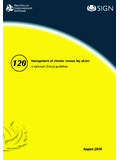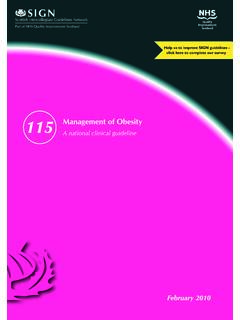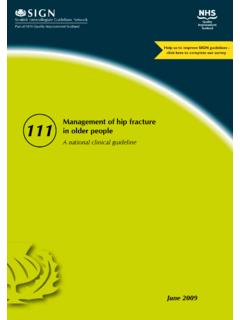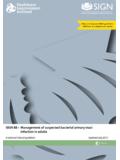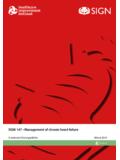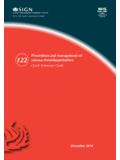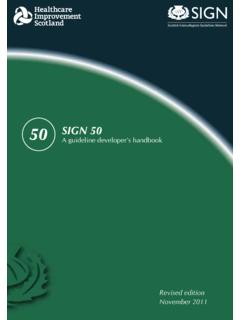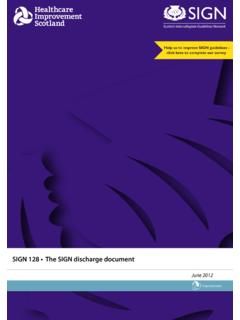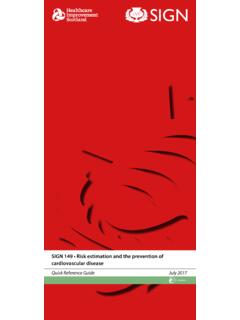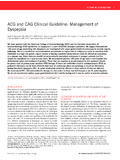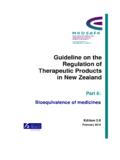Transcription of A national clinical guideline
1 management of diabetesA national clinical guidelineMarch 2010 Updated November 2017116 KEY TO EVIDENCE STATEMENTS AND GRADES OF RECOMMENDATIONSLEVELS OF EVIDENCE1++High quality meta-analyses, systematic reviews of RCTs, or RCTs with a very low risk of bias1+Well conducted meta-analyses, systematic reviews, or RCTs with a low risk of bias1 -Meta-analyses, systematic reviews, or RCTs with a high risk of bias2++ High quality systematic reviews of case control or cohort studies High quality case control or cohort studies with a very low risk of confounding or bias and a high probability that the relationship is causal2+Well conducted case control or cohort studies with a low risk of confounding or bias and a moderate probability that the relationship is causal2 - Case control or cohort studies with a high risk of confounding or bias and a significant risk that the relationship is not causal3 Non-analytic studies, eg case reports, case series4 Expert opinionGRADES OF RECOMMENDATIONNote: The grade of recommendation relates to the strength of the evidence on which the recommendation is based.
2 It does not reflect the clinical importance of the At least one meta-analysis, systematic review, or RCT rated as 1++, and directly applicable to the target population; or A body of evidence consisting principally of studies rated as 1+, directly applicable to the target population, and demonstrating overall consistency of resultsBA body of evidence including studies rated as 2++, directly applicable to the target population, and demonstrating overall consistency of results; orExtrapolated evidence from studies rated as 1++ or 1+CA body of evidence including studies rated as 2+, directly applicable to the target population and demonstrating overall consistency of results; orExtrapolated evidence from studies rated as 2++DEvidence level 3 or 4; orExtrapolated evidence from studies rated as 2+GOOD PRACTICE POINTS Recommended best practice based on the clinical experience of the guideline development groupNHS Quality Improvement Scotland (NHS QIS) is committed to equality and diversity and assesses all its publications for likely impact on the six equality groups defined by age, disability, gender, race, religion/belief and sexual guidelines are produced using a standard methodology that has been equality impact assessed to ensure that these equality aims are addressed in every guideline .
3 This methodology is set out in the current version of SIGN 50, our guideline manual, which can be found at The EQIA assessment of the manual can be seen at The full report in paper form and/or alternative format is available on request from the NHS QIS Equality and Diversity care is taken to ensure that this publication is correct in every detail at the time of publication. However, in the event of errors or omissions corrections will be published in the web version of this document, which is the definitive version at all times. This version can be found on our web site This document is produced from elemental chlorine-free material and is sourced from sustainable Intercollegiate guidelines NetworkManagement of diabetesA national clinical guidelineMarch 2010 management OF DIABETESISBN 978 1 905813 58 2 Published March 2010 Updated May 2011 Updated May 2014 Updated November 2017 This guideline was issued in 2010 and will be considered for review in three years.
4 The review history, and any updates to the guideline in the interim period, will be noted in the review report, which is available in the supporting material section for this guideline on the SIGN website: consents to the photocopying of this guideline for the purpose of implementation in NHSS cotlandScottish Intercollegiate guidelines Network Healthcare Improvement Scotland Gyle Square, 1 South Gyle Crescent Edinburgh EH12 Introduction .. The need for a guideline .. Remit of the guideline .. Definitions .. Statement of intent ..32 Key recommendations .. Lifestyle management .. Psychosocial factors .. management of type 1 diabetes .. management of diabetes in pregnancy .. management of diabetic cardiovascular disease .. management of kidney disease in diabetes .. Prevention of visual impairment .. management of diabetic foot disease ..83 Lifestyle management .
5 Delivery of lifestyle interventions .. Structured education .. Self monitoring of glycaemia .. Smoking cessation .. Exercise and physical activity .. Weight management in type 2 diabetes .. Healthy eating .. Alcohol .. Checklist for provision of information ..244 Psychosocial factors .. The influence of psychosocial factors on diabetes control .. Screening for psychological distress .. The effect of psychological interventions on diabetes outcomes .. Treatment of psychological distress .. Checklist for provision of information ..295 management of type 1 diabetes .. Diagnosis and epidemiology .. Initiating therapy at diagnosis .. Continuing management .. Quality of life ..36 CONTENTSMANAGEMENT OF Long term complications and screening .. Checklist for provision of information ..386 This section is superseded by SIGN 154 Pharmacological management of glycaemic control in people with type 2 diabetes .
6 397 management of diabetes in pregnancy .. Introduction .. Contraception .. Pre-pregnancy care .. Nutritional Optimisation of glycaemic control .. Complications during pregnancy .. Fetal assessment .. Gestational diabetes .. Delivery .. Infants of mothers with diabetes .. Postnatal care .. Follow up of women with GDM .. Checklist for provision of information ..688 management of diabetic cardiovascular disease .. Epidemiology .. Cardiovascular risk factors .. Primary prevention of coronary heart disease .. management of patients with diabetes and acute coronary syndromes .. management of patients with diabetes and heart failure .. management of patients with diabetes and stable angina .. management of acute stroke .. Peripheral arterial disease .. Checklist for provision of information ..819 management of kidney disease in diabetes .. Definitions.
7 Prevalence and progression of kidney disease in diabetes .. Screening for kidney disease in Investigation of kidney disease in diabetes .. Prevention and treatment of kidney disease in diabetes .. management of complications .. Models of care .. Checklist for provision of information ..9510 Prevention of visual impairment .. Risk identification and prevention .. Screening .. Treatment .. Rehabilitation .. Checklist for provision of information ..10211 management of diabetic foot disease .. Epidemiology and risk factors .. Risk stratification .. Patient education .. Preventative footwear and orthoses .. management of active foot disease .. Painful diabetic neuropathy .. Checklist for provision of information ..11012 Provision of information .. Sources of further information ..11113 Implementing the guideline .. Resource implications of key recommendations.
8 Auditing current practice .. Additional advice to NHSS cotland from NHS Quality Improvement Scotland and the Scottish Medicines Consortium ..11514 The evidence base .. Systematic literature review .. Recommendations for research .. Review and updating ..11815 Development of the guideline .. Introduction .. The guideline development group .. The guideline steering group .. Consultation and peer review ..123 Abbreviations ..125 Annex 1 ..130 Annex 2 ..140 Annex 3 ..142 References ..143 CONTENTSMANAGEMENT OF DIABETES11 INTRODUCTION1 Introduction THE NEED FOR A GUIDELINED iabetes mellitus is a major cause of morbidity and mortality in Scotland and worldwide, with an increasing prevalence. In 2009 there were around 228,000 people registered as having diabetes in Scotland, an increase of from the preceding This increase relates, in part, to the increasing age of the population, an increase in obesity and also perhaps to increasing survival of those with years ago the St Vincent declaration aimed to decrease blindness, end-stage renal failure, amputation and cardiovascular disease in those with diabetes and to improve the outcome of pregnant mothers who have diabetes .
9 Since that time there has been a great increase in evidence showing that many diabetic outcomes can be influenced by appropriate therapies. Part of this evidence base was reviewed in the previous SIGN guideline on management of diabetes (SIGN 55) published in New clinical evidence has been published since then and has resulted in the need for this selective update. Implementing the evidence described in this guideline will have a positive effect on the health of people with UPDATING THE EVIDENCES ince the publication of SIGN 55, new evidence has been published in many areas covered by the recommendations in that guideline . Where this evidence was thought likely to significantly change either the content or grading of these recommendations, it has been identified and reviewed. Where new evidence does not update existing recommendations and where no new evidence was identified to support an update, the guideline text and recommendations are reproduced verbatim from SIGN 55.
10 The original supporting evidence was not re-appraised by the current guideline development group. A number of new areas that were not considered in SIGN 55 have also been incorporated into this selective update, (see section ).A Cost and Resource Impact Assesment report developed by NHS QIS is available as a companion document to this guideline . This document reports the national costs to NHSS cotland of implementing recommendations that are estimated to have a net additional cost of 5 million or more to REMIT OF THE OVERALL OBJECTIVESThis guideline provides recommendations based on current evidence for best practice in the management of diabetes . For people with type 1 and type 2 diabetes recommendations for lifestyle interventions are included, as are recommendations for the management of cardiovascular, kidney and foot diseases. Guidance for all people with diabetes to prevent visual impairment, and specific advice for pregnant women with diabetes is provided.
